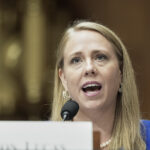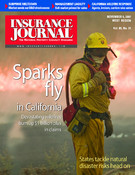Florida Insurance Commissioner Kevin McCarty is in the hot seat in his state, over the coastal property insurance controversy in particular. This interview with McCarty was conducted right before the auto no-fault law expired (lawmakers have since reinstated it for 2008) and before the state subpoenaed some of the largest property insurers to explain their rates.
For the complete video interview, visit www.insurancejournal.com/tv.
In January, Gov. Crist signed into law reforms that included making low-cost reinsurance available to property casualty insurers, with the idea being that the savings would be passed on to policyholders. How’s that working out?
McCarty: Well, you’re right, the governor did sign into law House Bill 1A in a special session. That really is a landmark piece of legislation that created an additional $12 billion worth of reinsurance capacity for the primary market, with the anticipation that the savings for that reinsurance would be passed on to the policyholders.
The expectation at the time was about 24 percent of the total premium would be passed on, on average. That’s always kind of misleading, because obviously it would be more in the high-density coastal areas in Dade County — which is our coastal area — than it would be in my area, like Tallahassee in Leon County.
But spread over the state, they expect a 24 percent savings. The initial presumed factor filings, as we call them, came in March 15. We were a little disappointed with the initial numbers; they were more like in the 12-14 percent range. Some of them came in a little bit higher.
But we’re still optimistic that as we go through those filings and then through the true-up filings, that the savings from House Bill 1A will be realized by the policyholders of Florida.
What was the reasoning for the lower than expected savings?
McCarty: Well, obviously when you have to come up with a presumed factor, you have to make certain assumptions in the marketplace. We took 13 different companies in Florida — large, medium, and small — to try and get a wide market share so that we can get a sampling as to what it would be.
The companies were then required to file in accordance with the requirements of the Florida law to supplant that insurance from their 2006. Some of them didn’t follow the methodology; some of them didn’t purchase up to the $12 billion dollars, so they didn’t purchase that amount. So there are a variety of factors.
We’re not accusing the industry of gaming the system, so to speak. But it’s very individual company specific. As you know, reinsurance is really specific to that company. And what works for one company, (they) might buy it on a global basis, and a Florida-only company might just buy it for the state of Florida. Some by quota share, some just by cat coverage. So there are a variety of reasons why it’s not.
[W]e still have some of our largest carriers that have not filed as of this time. State Farm and Allstate will be making their filings. So, again, some of the companies in the true-up filings have actually asked for increases in rates.
We’ve had eight public hearings so far in Florida. We’re trying to bring transparency to the process, so that consumers can be educated as to what goes into their rate filings. At this point, I would say that while we’re optimistic, we’re disappointed in especially some of the national carriers. There seems to be a real divide with the Florida carriers — who have passed along at least the 24 percent, and sometimes 30-35 percent of the savings — with the national carriers, who seem to have been reluctant to pass those savings on. Actually I think they’re frustrated with the Florida law in general, and probably do not want to see that be successful and want to see it repealed. But our governor and the Senate and the House are vigilant in providing relief to policyholders in Florida.
You’ve been a leader in calling for a national catastrophe plan. What elements would you like to see in such a program? And what do you tell the people in Nebraska or Wisconsin about the need for this or the wisdom of it?
McCarty: Well, actually I get that question a lot. I’ve been here in Washington several times to talk about a national catastrophic plan. What I mean by a national plan is an integrated plan that not only calls for a federal backstop, if you will, for coastal exposure, but also calls for land use planning for building codes, building code enforcement, retro-fitting the current housing stock, and having a partnership with state and federal governments and the private sector to ensure that we’re doing all we can to prevent the loss from happening to begin with. A number of coastal states and areas in the Gulf of Mexico didn’t have building codes when Hurricane Katrina hit.
Now here we are in 2004, 2005, and major areas of the country that are exposed do not have building codes. Obviously, a national plan has to integrate all of these things before we can ask citizens to participate in helping a coastal region.
But the fact of the matter now is we’re paying for the victims of Katrina that were not insured. The fact of the matter is if there’s an event in California with earthquakes, only 12 percent of those people have insurance.
We are a compassionate people. We are going to respond by rebuilding homes. We have a national cat plan today; it’s just not a very good one. What I’m advocating is that we have an integrated plan that foresees these things happening in the future. It’s not a matter of if, but when. When it happens, we want to make sure that we have building codes, we have search and rescue, we have the economic recovery that’s necessary to rebuild people’s homes, get the children back to school, and people back to work and contributing to the tax base and to the economic recovery of the catastrophically-exposed areas.
Insurers use proprietary catastrophe models. There is a debate over how much state regulators should know about what goes into these. What’s Florida’s experience with cat models?
McCarty: Florida probably has the most extensive experience with cat models. Obviously, cat models have been used since Hurricane Andrew as a tool for insurance companies, not only to determine what the appropriate rate is, but also to determine what the appropriate risk spread and the appropriate reinsurance mechanism or risk transfer. So they’re very important tools to use. I certainly don’t mean to criticize computer models, per se, because I think they play an important part for any underwriter to ensure that they have adequate resources to pay their claims.
Having said that, I think there is a larger public policy issue going on behind that. We know that there’s a great deal of disparity in the outcomes, sometimes 3,000-4,000 percent difference when you drill down to a zip code in a particular housing type structure, in a particular policy form. The aggregate state basis might be very similar, but rates are made on the ground level, and that’s what Joe and Mary “Average Joe” pay for their insurance. They don’t look at it as an aggregate state loss cost.
So obviously, we’re concerned with what those outcomes are. We’ve been very active in both the review of models through the modeling commission in Florida, which established 13 standards that these modelers have to meet. We have a professional team that goes into verify that these standards have been met. We also developed, starting in 2002, our own hurricane model, a public model that was developed through a consortium of state universities, and we use this as a benchmark to help us in rate review process.
Is that tailored to Florida then?
McCarty: Well, the Florida public model actually is only Florida. It’s only used as Florida data, but the principles are the same. It’s actually been through the Loss Methodology Commission. It abides by the 13 principles. So it goes through a similar vetting process as the commercial ones. The commercial ones have been built, however, on a national basis, or at least on a Gulf basis.
Do you think regional models make sense?
McCarty: Well I think there certainly is an appetite from the regulator community to move to a regional model, particularly the Gulf States, the Southeastern zone states. I think they’re very concerned about the rate developments in their state. But I also think, again, we look at this from a rate consumer protection. The other consumer protection is to insure that companies have the wherewithal to pay claims. We want to make sure that they have sufficient capital, sufficient reinsurance.
What did it cost Florida to develop its model?
McCarty: If you look at the development costs plus the maintenance costs, it’s about $7.5 million to $8 million.
Have the returns have been worth it?
McCarty: Well, we really only began using it about a year ago. And yes, we’re very, very pleased with our model. I think it’s a valuable tool. It brings transparency to the process; all of the information about the model is public. I think that builds confidence by the consumers of Florida, that whatever rate they’re paying has been vetted through a process that has transparency in it.
Also, I think it’s been a great educational tool for our legislature, for people who want to know more about risk management. And we’re now coupling this with our mitigation project, and what we can do to reduce overall exposure in certain areas and hopefully grow the capital necessary to cover risks in the future.
What has been done in loss mitigation in Florida?
McCarty: … I was in Lloyd’s two years ago with Governor Bush to see what we could do to bring more capital to Florida, and basically they told us that because of Florida’s unusual nature, because of the concentration of risk and the high catastrophic exposure, that there wasn’t enough capital to cover Florida risk. The only thing that could be done is to somehow figure out a way of getting your arms around the over $4 plus trillion exposure in Florida. … Eighty percent of our housing stock was built before the modern housing codes. We need to figure a way of retro-fitting that housing stock to make it more wind-resistive, not only to make it more insurable, but if you think about it, Florida’s a peninsula and if a storm comes, there’s not a lot of mountain places, not a lot of places to run and hide.
Florida has actually initiated a $250,000 Save Our Homes program, which initiated inspections and grant programs to get Floridians to fortify their homes. We also have the mandatory credits and discounts that all insurance companies are required to offer. Those credits were doubled in January. It’s obviously one of the more effective ways of motivating consumers. Some of the credits can be as much as 60 percent of wind premium.
So there are substantial credits that can be earned by policyholders if they take necessary steps to mitigate against future losses.
Was this article valuable?
Here are more articles you may enjoy.


 FBI Involved After Two Florida Injury Lawyers Go Missing From Fishing Trip
FBI Involved After Two Florida Injury Lawyers Go Missing From Fishing Trip  Twice Injured Firefighter Loses Second Workers’ Compensation Claim
Twice Injured Firefighter Loses Second Workers’ Compensation Claim  Aon Adds to List of Brokers Suing Howden US for Alleged Poaching, Theft
Aon Adds to List of Brokers Suing Howden US for Alleged Poaching, Theft  Head of EEOC Urges White Men to Report Discrimination
Head of EEOC Urges White Men to Report Discrimination 


